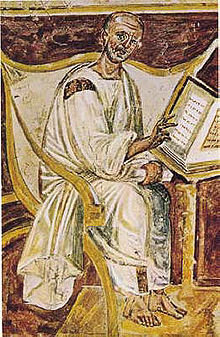Teaching rhetoric
Augustine taught grammar at Thagaste during 373 and 374. The following year he moved to Carthage to conduct a school of rhetoric and would remain there for the next nine years.[28]Disturbed by unruly students in Carthage, he moved to establish a school in Rome, where he believed the best and brightest rhetoricians practised, in 383. However, Augustine was disappointed with the apathetic reception. It was the custom for students to pay their fees to the professor on the last day of the term, and many students attended faithfully all term, and then did not pay. Manichaean friends introduced him to the prefect of the City of Rome,Symmachus, who had been asked by the imperial court at Milan[38] to provide a rhetoric professor.
Augustine won the job and headed north to take his position in late 384. Thirty years old, he had won the most visible academic position in the Latin world at a time when such posts gave ready access to political careers. Although Augustine showed some fervour for Manichaeism, he was never an initiate or "elect", but an "auditor", the lowest level in the sect's hierarchy.[38]
While still at Carthage a disappointing meeting with the Manichaean Bishop,Faustus of Mileve, a key exponent of Manichaean theology, started Augustine's scepticism of Manichaeanism.[38] In Rome, he reportedly turned away from Manichaeanism, embracing thescepticism of the New Academymovement. Because of his education, Augustine had great rhetorical prowess and was very knowledgeable of the philosophies behind many faiths.[39] At Milan, his mother's religiosity, Augustine's own studies inNeoplatonism, and his friendSimplicianus all urged him towards Christianity.[28] Initially Augustine was not strongly influenced by Christianity and its ideologies, but after coming in contact with Ambrose of Milan, Augustine reevaluated himself and was forever changed.
Like Augustine, Ambrose was a master of rhetoric, but older and more experienced.[40] Augustine was very much influenced by Ambrose, even more than by his own mother and others he admired. Augustine arrived in Milan and was immediately taken under the wing by Ambrose. Within Augustine’s work, Confessions, Augustine states, “That man of God received me as a father would, and welcomed my coming as a good bishop should.”[41] Soon, their relationship grew, as Augustine wrote, "And I began to love him, of course, not at the first as a teacher of the truth, for I had entirely despaired of finding that in thy Church—but as a friendly man”.[41] Augustine visited Ambrose in order to see if Ambrose was one of the greatest speakers and rhetoricians in the world. More interested in his speaking skills than the topic of speech, Augustine quickly discovered that Ambrose was a spectacular orator. Eventually, Augustine says that through the unconscious, he was led into the faith of Christianity.[42]
Augustine's mother had followed him to Milan and arranged a marriage for which he abandoned his concubine. Although Augustine accepted this marriage, Augustine was deeply hurt by the loss of his lover. He said, "My mistress being torn from my side as an impediment to my marriage, my heart, which clave to her, was racked, and wounded, and bleeding." Augustine confessed that he was not a lover ofwedlock so much as a slave of lust, so he procured another concubine since he had to wait two years until his fiancée came of age. However, his wound was not healed, even began to fester.[43]
There is evidence that Augustine may have considered this former relationship to be equivalent to marriage.[44] In his Confessions, he admitted that the experience eventually produced a decreased sensitivity to pain. Augustine eventually broke off his engagement to his eleven-year-old fiancée, but never renewed his relationship with either of his concubines. Alypius of Thagastesteered Augustine away from marriage, saying that they could not live a life together in the love of wisdom if he married. Augustine looked back years later on the life at Cassiciacum, a villa outside of Milan where he gathered with his followers, and described it asChristianae vitae otium – the Christian life of leisure.culled from Wikipedia


No comments:
Post a Comment